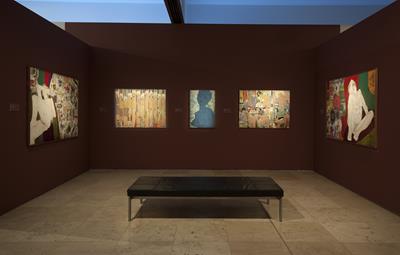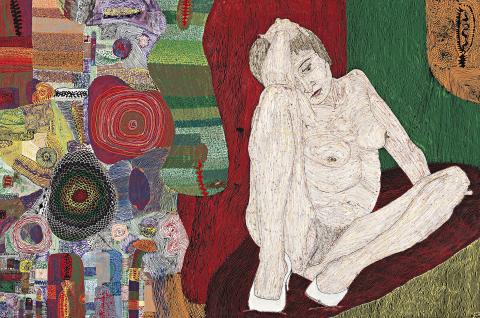DITHYRAMBIC PAINTING, 1965
RICHARD LARTER
enamel on composition board
121.0 x 182.0 cm
signed with initials and dated lower right: RL 65
Watters Gallery, Sydney
The Collection of Colin and Elizabeth Laverty, Sydney, acquired from the above in December 1984
The Laverty Collection, Museum of Contemporary Art, Sydney, 20 June – 23 August 1998
An Exhibition At Two Venues – An Exhibition to Celebrate Richard Larter’s Seventieth Birthday, Watters Gallery, Sydney and Legge Gallery, Sydney, 4 – 22 May 1999, cat. 15 (as ‘Dithyrambic painting No. 2’)
Stripperama – Richard Larter, Heide Museum of Modern Art, Melbourne, 18 May – 28 July 2002 (label attached verso); then touring to: New England Regional Art Museum, New South Wales, 16 August – 6 October 2002 (cat. 12)
The difference between you and me, The Ian Potter Museum of Art, University of Melbourne, Melbourne, 6 August – 16 October 2005, cat. 5 (illus. in exhibition catalogue)
Laverty 2, Newcastle Region Art Gallery, New South Wales, 14 May – 14 August 2011
Loxley, A., ‘The Laverty Collection’, Art and Australia, Sydney, 1996, vol. 34, no. 1, p. 72
Gellatly, K., Stripperama – Richard Larter, Heide Museum of Modern Art, Melbourne, 2002, pp. 10 (illus.), 42
Laverty_2_Install_09.jpg

‘In Larter’s world, sex, desire, pleasure and the related aspects of voyeurism and performance are not only natural, but to be celebrated’.1
The idiosyncratic techniques employed by Richard Larter enabled highly original paintings of remarkable colour, innovation and on many occasions, provocative and challenging subjects. The artists’ notorious use of the hypodermic syringe to ‘draw’ with paint is one example of the inventiveness that pervades Larter’s art. While awaiting a bus, Larter noticed in the window of a medical supplies store a display of hypodermic syringes and immediately recognised the potential of the syringes to control and manipulate paint on board. This particular, self-taught technique flourishes in many of the artist’s works of the 1950s and 1960s, with the Dithyrambic paintings of 1965 highlighting the ability of this method to intensify the sensory experience of an artwork.
Painted in the year of his first exhibition at the progressive Watters Gallery in Sydney, Dithyrambic Painting, 1965 was included in a major exhibition of Larter’s figurative work, 'Stripperama', held at the Heide Museum of Modern Art in 2002. Featuring his most adored model, his wife Patricia, Dithyrambic Painting is an excellent example of the uninhibited sensuality prominent in Larter’s works. Both Richard and Pat Larter (an artist in her own right) believed in the positive expression of female sexuality. Pat’s modelling, and consequently, the artists’ depictions of the female form are not intended to be idealised. Rather, they propose to illustrate the natural movement and sexual liberation of the model – a calculated slight against the conservative government attitudes of the time. Modesty set aside, the model appears preoccupied, concerned with neither her audience nor her disarmingly brazen nudity.
The decorative, richly patterned background of Dithyrambic Painting is balanced equally with the figurative aspects of the painting, emphasising the artist’s propensity to stray from the techniques commonly taught in traditional art education. ‘After all, if Picasso (old enough to be my grandfather then) could paint both abstract and figurative why should not I? He empowered me – he was saying “please yourself sunshine”’.2
1. Gellatly, K., Stripperama: Richard Larter, Heide Museum of Modern Art, Melbourne, 2002, p. 24
2. Larter, R., Incondite incantations: for Pat, self-published, Sydney, 2001, p. 102
MELISSA HELLARD
